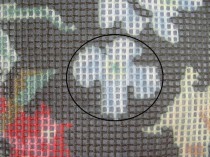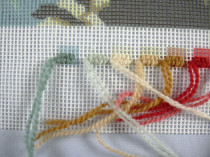How to Use Pre-package Kits
We have many kits on
the market that can fit nicely in your home. In the shops, you can find thousands of ideas from pictures to pillows. Before you buy one, consider the pros and cons of kits. First,
purchase the best kit you can afford. A kit is an excellent learning tool. You can determine if you enjoy needlepoint and everything you will need for the project will be there except for
pillow stuffing or picture frame.
After you purchase the kit, bring it home and open the package. You should see the canvas, threads, instruction and a needle. Kits usually come with only one needle. You may wish to purchase a package of the correct size needle. (See Needle Sizes) There is nothing more irritating than losing your needle in the middle of the night when you wish to continue stitching.
At this point, you need to determine if you wish to stitch on stretcher bars or hold the canvas in your hand. For information on mounting on stretcher bars, see Mounting On Stretcher Bars.
Be sure to read the directions to see what stitch you should use. A kit normally includes enough thread to finish the job. If the instructions tell you to stitch Half Cross do so. This stitch uses less thread than Continental or Basketweave. More decorative stitches usually use more thread than Half Cross.
Some of the intersections have two different colors. You may ask, what color do I use? Example, do I stitch blue or white? To answer, look at the canvas. When the intersection has more white than blue, white should be stitched. If the intersection has an equal portion of each color and is not obvious as to which one is correct, work freely with your needle. When a circle, look at the circle and work on your own. You want natural looking curves which are true to live. Never create large steps.
If you worked the needlepoint using the sewing method, you will need to block the needlepoint. See Make a Blocking Board and Blocking-Wet Method or Blocking-Steam Method.

















